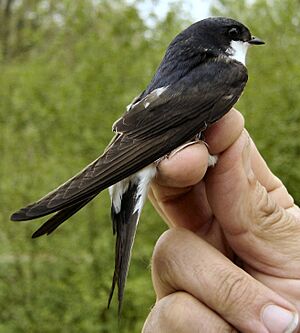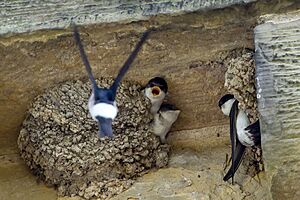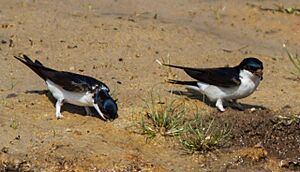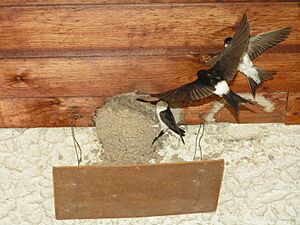Western house martin facts for kids
Quick facts for kids Western house martin |
|
|---|---|
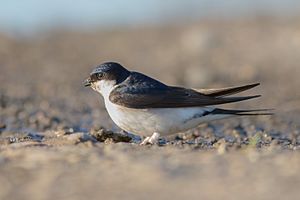 |
|
| near Bredstedt, Schleswig-Holstein, Germany | |
| Conservation status | |
| Scientific classification | |
| Genus: |
Delichon
|
| Species: |
urbicum
|
 |
|
| Range of D. urbicum Breeding Passage Non-breeding | |
| Synonyms | |
|
|
The western house martin (Delichon urbicum) is a small, migratory bird from the swallow family. You might also hear it called the common house martin or just house martin. These birds breed in Europe, North Africa, and parts of Asia. When winter comes, they fly south to sub-Saharan Africa and tropical Asia.
House martins eat insects they catch while flying. They travel to places where there are lots of flying insects. They have a blue head and back, a white rump (the area above their tail), and pure white undersides. You can find them in open areas and often close to people's homes. They look a lot like two other martin species found in Asia.
Both the scientific and common names for this bird are about how it uses human buildings. It builds a cup-shaped nest from mud pellets. These nests are usually found under the eaves of buildings, often in large groups called colonies.
House martins can be hunted by birds like the Eurasian hobby. Like other birds, they can also get parasites. Even so, the western house martin is not globally threatened. This is because it has a very large population and lives in many different places.
Contents
About the House Martin's Name
The western house martin was first described by a famous scientist named Carl Linnaeus in 1758. He called it Hirundo urbica. Later, in 1854, it was placed in its current group, Delichon.
The name Delichon is a rearranged version of an ancient Greek word, chelīdōn, which means "swallow." The species name urbicum comes from Latin and means "of the town." This name fits because these birds often live near towns and cities.
The Delichon group of birds is closely related to the barn swallow group. All three birds in the Delichon group look similar. They have blue upper parts, a white rump, and whitish undersides. The western house martin is special because it has a pure white rump and pure white undersides.
What Does a House Martin Look Like?
An adult western house martin is about 13 cm (5 in) long. Its wings can spread out to 26–29 cm (10–11+1⁄2 in) wide. It usually weighs around 18.3 g (21⁄32 oz). Its back is a shiny steel-blue color, and it has a bright white rump. Its belly and even the feathers under its wings are also white.
Its short legs have white, fluffy feathers. It has brown eyes and a small black beak. Both male and female house martins look alike. Young birds are a sooty black color. They have white tips on some of their wing feathers.
The white rump and undersides of the western house martin are easy to spot when it flies. This helps tell it apart from other swallows. For example, the barn swallow has a darker rump. The western house martin flies quickly, beating its wings about 5.3 times per second.
House martins are quite noisy, especially when they are nesting together. The male bird's song is a soft, musical chirping sound. They also make a sharp "chirrrp" sound to communicate. If they sense danger, they let out a high-pitched "tseep" alarm call.
House Martin Homes and Journeys
Western house martins breed across Europe and Asia, as far east as Mongolia. They also breed in Morocco, Tunisia, and northern Algeria. When winter arrives, they fly south to sub-Saharan Africa.
These birds like open areas with low plants, like pastures, meadows, and farms. They prefer to be near water. They can also be found in mountains, even up to 2,200 m (7,200 ft) high. House martins are more likely to live in cities than barn swallows. They will even nest in city centers if the air is clean. They often stay near trees, which provide insects to eat and places to rest.
During winter, they live in similar open habitats. However, they are harder to spot than barn swallows. They tend to fly higher and move around more. In tropical areas, they seem to prefer higher places.
House martins are long-distance migrants. They fly across wide areas, including the Mediterranean Sea and the Sahara Desert. They eat insects while they fly and usually travel during the day. Migration can be dangerous. For example, in 1974, many thousands of these birds died in the Swiss Alps. They were caught in heavy snowfall and very cold weather.
House martins usually return to their breeding grounds a few days after the first barn swallows. If the weather is bad, they often hunt for food over large bodies of fresh water before going to their nests. Sometimes, house martins have stayed to breed in Namibia and South Africa instead of flying back north.
House Martin Life Cycle
Building Nests and Laying Eggs
Originally, western house martins nested on cliffs and in caves. Some still do. But now, they mostly use human buildings like bridges and houses. Unlike barn swallows, which nest inside barns, house martins build their nests on the outside of buildings. They build them where a wall meets an overhang, like under house eaves. This helps make the nest strong.
Breeding birds come back to Europe between April and May. Nest building starts from late March in North Africa to mid-June in Lapland. The nest is a neat, closed, cup-shaped structure. It has a small opening at the top. Both the male and female birds build it using mud pellets they collect with their beaks. They line the nest with soft materials like grass or hair. The mud is gathered from ponds, streams, or puddles.
House sparrows sometimes try to take over house martin nests while they are being built. If the sparrows succeed, the house martins will build a new nest somewhere else. Once the nest is finished, the opening is too small for sparrows to get in.
House martins usually nest in colonies. Their nests can even touch each other. A typical colony has fewer than 10 nests, but some have thousands! The female usually lays four or five white eggs. Each egg is about 1.9 cm × 1.33 cm (3⁄4 in × 17⁄32 in) in size and weighs about 1.7 g (1⁄16 oz).
The female does most of the incubation, which takes about 14–16 days. When the chicks hatch, they are helpless. After another 22–32 days, depending on the weather, the young birds leave the nest. The parents continue to feed the young birds for about a week after they fledge. Sometimes, young birds from the first brood will help feed the second brood.
Raising Young and Migration
House martins usually have two broods (sets of chicks) each year. They often reuse the same nest for the second brood. They will also repair and use the nest again in future years. About 90% of eggs hatch, and 60–80% of the chicks survive to fledge. Sometimes, they have a third brood, but these late chicks often don't survive.
Most adult house martins live less than five years. However, some have been known to live for 10 or even 14 years. After leaving the nest, young birds gather in larger and larger groups. As the season goes on, you might see them resting in trees, on rooftops, or on wires with swallows. By the end of October, most house martins have left their breeding areas in Europe.
Once a pair of house martins forms, they usually stay together for life. However, it's common for them to mate with other birds too. This means that while they live together as a pair, the chicks in a nest might have different fathers. Studies have shown that some chicks are not related to the male bird in their nest.
Western house martins have sometimes bred with barn swallows. This is one of the most common mixed-species pairings among small birds.
What Do House Martins Eat?
The western house martin eats insects it catches while flying. This is similar to other birds that eat insects in the air, like swallows and swifts. In their breeding areas, their diet mostly consists of flies and aphids. In Europe, house martins eat more aphids and small flies than barn swallows. In their wintering areas, flying ants are an important food source.
During the breeding season, house martins usually hunt about 21 m (69 ft) high. But they fly lower when it's wet. They typically hunt within 450 m (1,480 ft) of their nest. They prefer open ground or water, especially in bad weather. They will also follow farm equipment or large animals to catch insects that are disturbed. In their wintering grounds, they hunt at higher altitudes, over 50 m (160 ft).
Dangers and Health for House Martins
The Eurasian hobby (a type of falcon) hunts western house martins. But house martins are very good at flying, which helps them escape most predators.
House martins can get external fleas and mites, like the "house martin flea." They can also get internal endoparasites (parasites inside their bodies). These internal parasites, like avian malaria, are spread by insects that bite, such as mosquitoes. One study found that house martin nests often had more than 29 external parasites.
House Martin Conservation
The western house martin lives in a very large area, estimated to be 30,800,000 km2 (11,900,000 sq mi). Its population in Europe is thought to be between 22 and 47 million birds. While the total number of house martins around the world isn't precisely known, their numbers do go up and down. Because they are so widespread and numerous, they are listed as a species of least concern on the IUCN Red List. This means they are not currently threatened with extinction.
Historically, house martins have actually benefited from humans clearing forests. This created the open spaces they like. Human buildings also gave them many safe places to build nests. New houses have created even more nesting spots. Cleaner air in cities has also allowed them to breed in major city centers. For example, in Sheffield, UK, there are an estimated 12,353 house martins.
However, local populations can change for several reasons. Bad weather, pesticides used in farming, a lack of mud for building nests, and competition with house sparrows can reduce their numbers. Since 1970, there have been reports of fewer western house martins in central and northern Europe.
People usually don't mind house martins nesting on their buildings because they are attractive birds that eat flying insects. However, their droppings can be messy, which sometimes leads to people removing their nests.
House Martins in Stories and Art
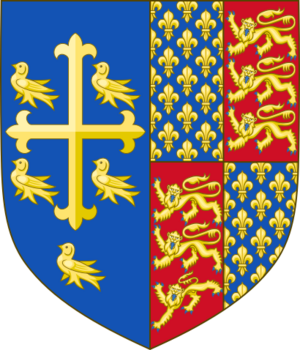
The house martin doesn't appear in as many stories as its relative, the barn swallow. But some old writings about swallows might actually be talking about house martins. For example, in William Shakespeare's play Macbeth, a character named Banquo describes house martins nesting at Macbeth's castle:
"This guest of summer,
The temple-haunting martlet, does approve
The air is delicate." (Macbeth, Act I, scene VI).
By his loved mansionry that the heaven's breath
Smells wooingly here. No jutty, frieze,
Buttress, nor coign of vantage, but this bird
Hath made his pendant bed and procreant cradle;
Where they most breed and haunt, I have observed
There are also old legends about house martins. One story says they would trap house sparrows inside their mud nests by closing the entrance. Another says they would gather in large groups to kill a sparrow. These stories are not true.
The martlet is a bird often seen in heraldry (the art of designing coats of arms). It's believed to represent the house martin or a swallow. A martlet is shown without feet, with only short feathery tufts instead. It was a symbol for the fourth son of a noble family, who often didn't inherit land. The lack of feet showed it couldn't land, linking it to a landless younger son. It also represented swiftness. You can see martlets in many coats of arms, including those of the House of Plantagenet.



